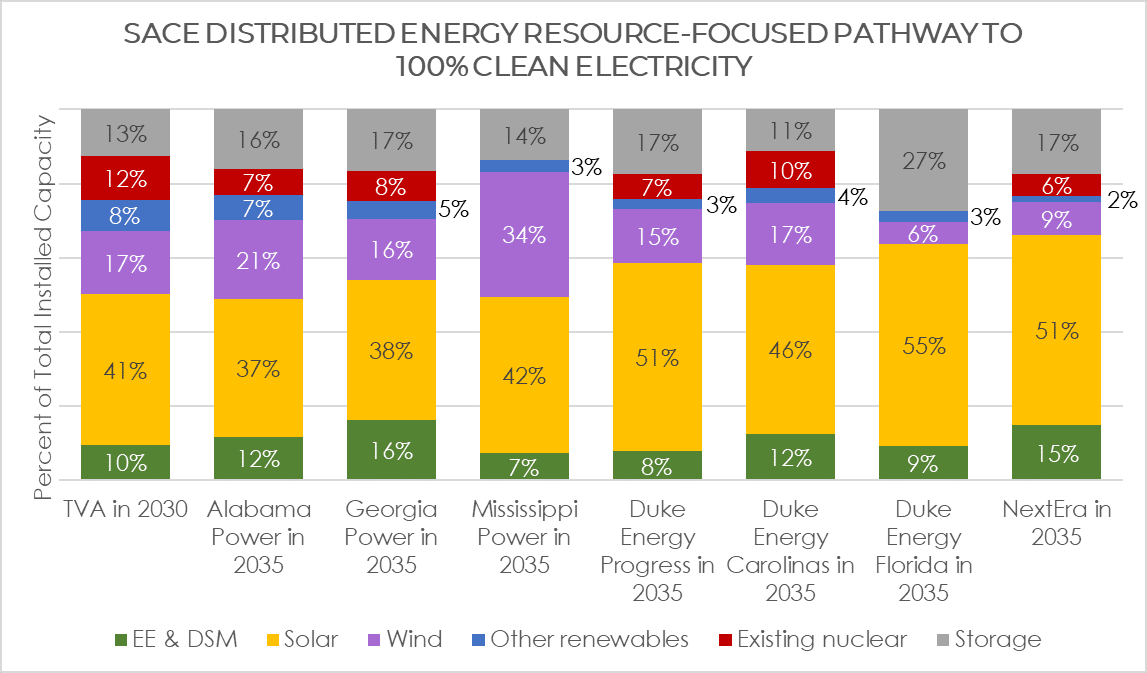We need BOTH utility-scale solar AND distributed solar in order to transform power generation and achieve 100% clean electricity by 2035.
Bryan Jacob | July 14, 2021 | Solar, Utilities
Download the Report
Watch the Report Webinar
Read the Report Blog Series
I’m as competitive as the next guy. (The Tokyo Olympics starts next week and some of you know about my Olympic pedigree.) But I want to devote today’s blog toward the fallacy that distributed solar and utility-scale solar are in competition with one another.
In our webinar that accompanied the launch of SACE’s fourth annual “Solar in the Southeast” report, some participants raised questions about the costs of rooftop solar versus utility-scale solar and the benefits of one versus the other. Brenden Rivers from the WJCT, which covers Jacksonville, Florida, captured how I summed up my response:
According to Jacob, both utility-scale and distributed solar are necessary if utilities want to reach 100% clean energy. “It’s not an either or proposition, it’s really a both and,” he said.
In a blog post from 2018 about the very first annual “Solar in the Southeast report,” I wrote: “Our vision at SACE is for all market segments of solar to succeed: utility-scale along with (not to the exclusion of) residential rooftop, community-scale and commercial/industrial. We advocate for policies and programs that offer a fair opportunity for solar to succeed at all scales, and we oppose abusive utility practices that restrict these opportunities.”
A False Dichotomy
The New York Times published a presumably well-intended article on Sunday, July 11, “More Power Lines or Rooftop Solar Panels: The Fight Over Energy’s Future” (subscription required), which was met with a prompt critique on social media and a dissenting opinion yesterday, July 13, by Canary Media: “The rooftop solar vs. transmission showdown that wasn’t.”
Mark Dyson of Rocky Mountain Institute summed it up well on Twitter:
I now believe that the @nytimes article on transmission-vs.-distributed solar was just a ploy to prompt energy experts to realize we all agree that it’s “both/and” not “either/or,” set aside our differences, and get on with reducing CO2. Well played… well played.
A Clean Electricity Standard Necessitates Both
SACE is calling on Congress to pass a Clean Electricity Standard (CES) – 100% by 2035 as envisioned by President Biden in the framework of the American Jobs Plan. We’re not alone in this clarion call – others are part of this chorus – just last week, 75 businesses called for a CES. And there’s widespread voter support for such legislation. David Roberts (@drvolts) covered clean electrification in a recent installment of Volts.wtf: “On climate policy, there’s one main thing and then there’s everything else”; and A Matter of Degrees, hosted by Dr. Leah Stokes and Dr. Katharine Wilkinson, devoted an episode to this just this week: “Let’s Go Get Us A Clean Electricity Standard.”
Companion research from SACE examined pathways and portfolios that could enable the four largest utility systems in the Southeast to achieve 100% clean electricity by 2035 (even 2030 in the case of TVA). Fulfilling a CES will require a combination of clean electricity resources. SACE’s “Achieving 100% Clean Electricity in the Southeast: Enacting a Federal Clean Electricity Standard” report and associated appendices illustrate that we need far more solar in the portfolios than any of our region’s largest utilities are currently planning.

The primary pathway in the SACE analysis prioritizes distributed energy resources (DERs) for fulfilling the utilities’ anticipated load prior to expanding centralized generation. Some common examples of DERs include residential, commercial, and industrial energy efficiency measures, customer-sited solar, often on rooftops, and demand response. The discrepancies between utility plans and the levels of solar necessary for 100% clean electricity by 2035 were particularly obvious for distributed solar.

Utility-scale solar (represented in blue) far exceeds distributed solar in each of the Southeast states. But some states have appreciably more distributed solar (in yellow) than others.
Alabama and Mississippi have almost no distributed solar and Tennessee isn’t much better. Our “Solar in the Southeast” illustrates this (above) and goes on to assert that, “Distributed solar will continue to struggle in Alabama even after the pandemic due to anti-solar policies imposed by TVA and Alabama Power.”
Policies at these utilities will need improvement to drive adequate solar expansion. The SACE portfolio for Alabama Power to fulfill a 100% CES by 2035 would require over 3,500 MW of distributed solar; TVA would require almost 5,800 MW.
Resource plans for utility-scale solar also must scale up considerably to fulfill a CES, as well. Both utility-scale and distributed solar are necessary if utilities want to reach 100% clean energy. “It’s not an either-or proposition, it’s really a both-and.” You can find more details of major Southeast utility’s current resource plans and our alternative pathways that get them to 100% clean electricity sooner than they are currently projected in our companion report, “Achieving 100% Clean Electricity in the Southeast: Enacting a Federal Clean Electricity Standard.”
Take Action
Join us in our call and take one minute to express your support for a Clean Electricity Standard to elected officials.
More report resources are available below.
Download the Report
Watch the Report Webinar
Read the Report Blog Series
#SSR2021